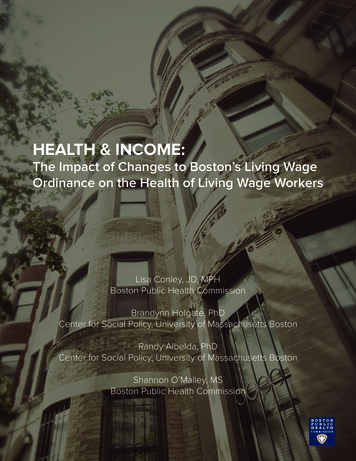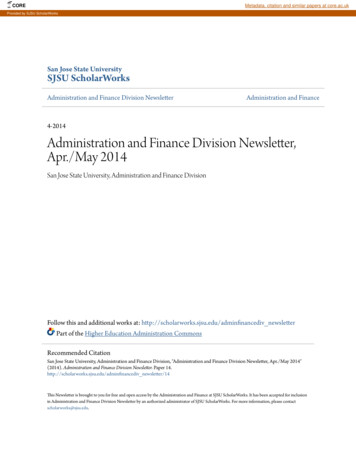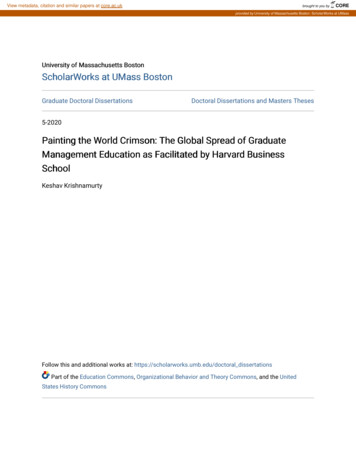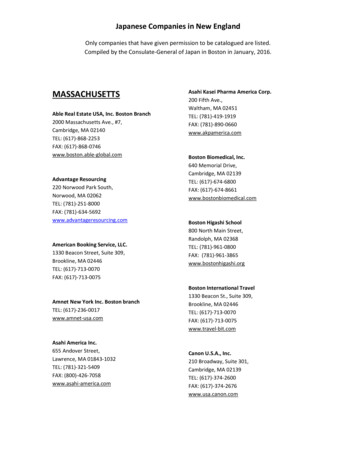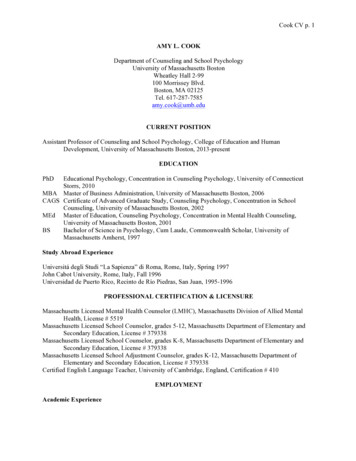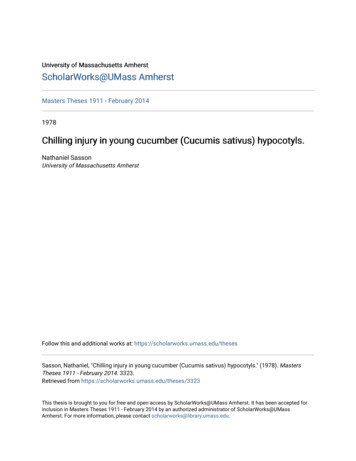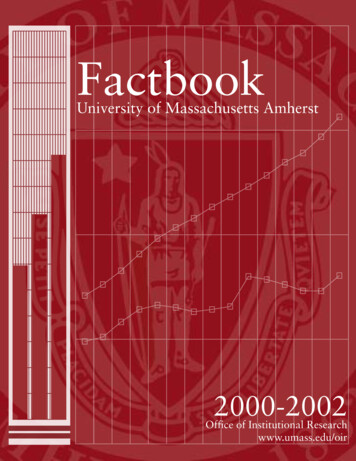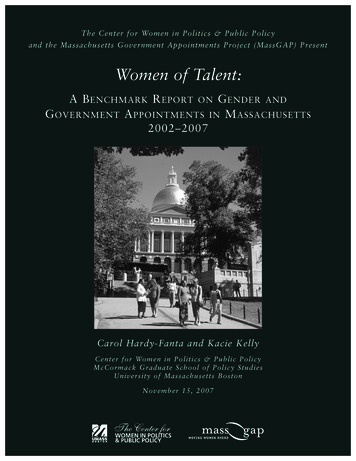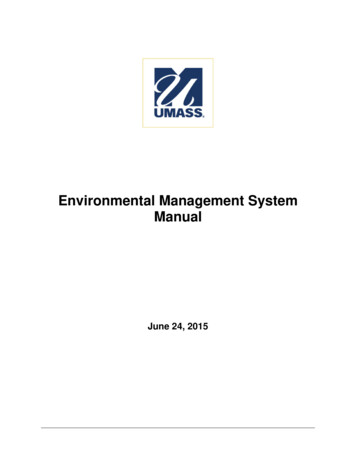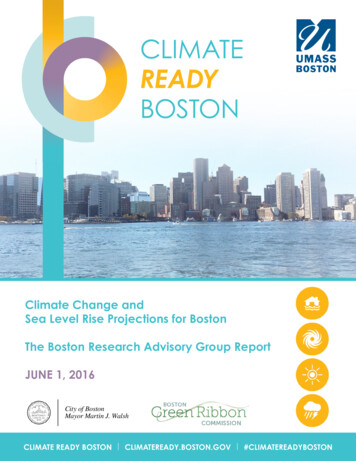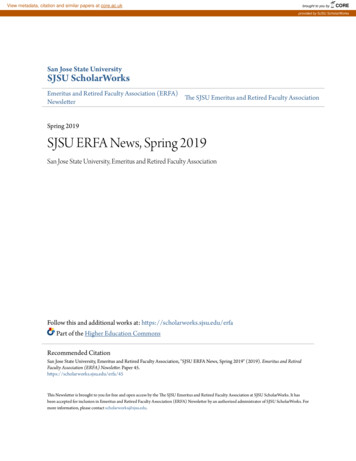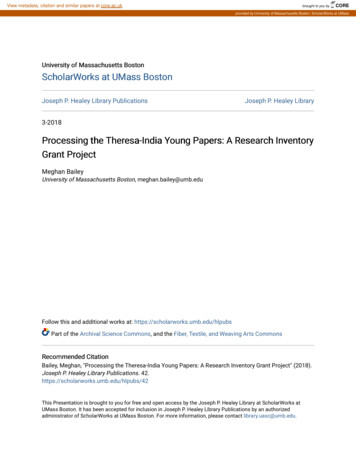
Transcription
View metadata, citation and similar papers at core.ac.ukbrought to you byCOREprovided by University of Massachusetts Boston: ScholarWorks at UMassUniversity of Massachusetts BostonScholarWorks at UMass BostonJoseph P. Healey Library PublicationsJoseph P. Healey Library3-2018Processing the Theresa-India Young Papers: A Research InventoryGrant ProjectMeghan BaileyUniversity of Massachusetts Boston, meghan.bailey@umb.eduFollow this and additional works at: https://scholarworks.umb.edu/hlpubsPart of the Archival Science Commons, and the Fiber, Textile, and Weaving Arts CommonsRecommended CitationBailey, Meghan, "Processing the Theresa-India Young Papers: A Research Inventory Grant Project" (2018).Joseph P. Healey Library Publications. 42.https://scholarworks.umb.edu/hlpubs/42This Presentation is brought to you for free and open access by the Joseph P. Healey Library at ScholarWorks atUMass Boston. It has been accepted for inclusion in Joseph P. Healey Library Publications by an authorizedadministrator of ScholarWorks at UMass Boston. For more information, please contact library.uasc@umb.edu.
PROCESSING THE THERESA-INDIA YOUNG PAPERS:A RESEARCH INVENTORY GRANT PROJECTPresented as part of the session “Enhancing Underrepresented Collections and ReachingNew Users” for the New England Archivists and Archivists Round Table of MetropolitanNew York Joint Spring Meeting in New Haven, Connecticut, March 24, 2018. The sessionwas the winner of the Inclusion & Diversity Session and Travel Assistance Award.Meghan BaileyProcessing Archivist and Grant Project DirectorUniversity Archives and Special CollectionsJoseph P. Healey Library, University of Massachusetts Bostonmeghan.bailey@umb.eduINTRODUCTIONThe University Archives and Special Collections department in the Joseph P. Healey Library atUMass Boston was awarded a Research Inventory Grant from Mass Humanities in June 2017.This allowed us the opportunity to devote a significant amount of time and resources to acquire,arrange, and describe the papers of noted Boston fiber artist, educator, and artist activist,Theresa-India Young. View the finding aid for the Theresa-India Young papers here. An exhibitshowcasing materials from the collection is planned for June 2018 at the Grossmann Gallery inthe Joseph P. Healey Library. The following is a presentation that describes who Theresa-IndiaYoung was, her work, and the importance of the collection, followed by a description of theprocess of acquiring the papers, the grant project, lessons learned, and a conclusion.THERESA-INDIA YOUNG AND HER PAPERSThe Theresa-India Young papers, spanning 44.75 linear feet, document her work as a fiber artist,interdisciplinary arts teacher, and education consultant working in the Boston area from 19752008. Young taught studio art and museum education at Massachusetts College of Art andDesign, where a scholarship is endowed in her name. She also taught at the Museum of FineArts, Roxbury Community College, Boston Public Schools, Elma Lewis School of Fine Arts,Harvard University Museum, Cambridge Friends School, Lesley University, and WheelockCollege.The collection documents her involvement with the Piano Craft Guild Tenants' Association andPiano Factory Gallery. The records for the Piano Craft Guild Tenants' Association is housed atthe University Archives and Special Collections; access to the collection finding aid can befound here: ion/p15774coll8/id/258/rec/84.Young was a mentor in her community, helping her colleagues and local youth claim theiridentities as artists, and pursue opportunities related to those roles. She served as an advocate for1
her fellow artists at the Piano Factory Studios when rising rent threatened to displace residentartists.Young mentored Boston youth by developing the Kush Club, a teen docent program, andmanaged Primal Arts, an educational consulting business that specialized in culturalpresentations, art workshops, and museum tours. As a teacher and purveyor of cultural heritage,Young worked to preserve and maintain folk art traditions in her artwork, such as the Gullahheritage of basket weaving. Her work was informed by her research into African aesthetics andtraditions, particularly weaving and hair braiding. She was also prolific in ceramics, EuropeanTapestry, and ethnic weaving.Much of Young’s research is preserved in the collection, in the form of clippings, handwrittennotes and varied publications. As a longtime resident of the Piano Factory, Young lived andworked within a dynamic local arts scene. The collection documents her relationships with otherlocal artists, like Allan-Rohan Crite, as well as the issues they faced, such as affordable housing.This collection consists of correspondence, handwritten notes, curriculum research, meetingminutes, scrapbooks, clippings, publications, ephemera, photographs, slides, and original artworkby herself and others, and includes personal papers relating to her early years in New York, hereducation, and genealogical research of her Gullah heritage in South Carolina and Africa.The importance of this collection cannot be overstated. The papers will provide researchersaccess to an under represented areas of art, culture, and race in Boston. This collection will be ofparticular interest to the diverse student and faculty population at UMass Boston and play animportant role in connecting this community with University Archives and Special Collections.It is important for students to see their culture and experiences represented in our collections.Research areas include but are not limited to; African-American art and artists in Boston, fiber,textile, and weaving arts, multicultural education, museum education, and artist tenancy rights.The University Archives and Special Collections also hold the records of the Piano Craft GuildTenants’ Association, 1972-2010, bulk 1989-1997 which provide researchers with a completepicture of Young's life while living at the Piano Factory Studios in the South End of Boston.ACQUIRING THE TIY PAPERS BEGINNINGSIt took University Archives and Special Collections (UASC) six years of planning andcultivating a relationship with the donor before we were able to acquire the resources to bring thecollection to the archives. The donor, Jacquelyn L. McRath, approached UASC in 2012 after alocal institution declined to take the papers and recommended UMass Boston. We were veryinterested in the collection since it fit our collection policy. A staff member conducted apreliminary inventory of the collection at the two storage locations it was located. The collectionat the time spanned 40 linear feet. We were unable take in the collection at the time due to ourlack of space and resources to transfer the collection. The University Archivist kept in touch withthe donor, cultivating an important relationship.2
In 2017, the Healey Library administration and UASC began focusing on grant fundingopportunities. Responsibilities of librarian, Mary Moser shifted to Outreach, Marketing,Fundraising, and Grants providing UASC with the committed effort and support to acquiring theresources to fund work on the collection. I worked closely with Mary Moser to apply for theMass Humanities Research Inventory Grant of 2,000 to process the Theresa-India Youngpapers. In June of 2017, we received notification that our application was approved.GRANT PROJECTThe Research Inventory Grant funded the transportation of the collection to UASC, and the workof professional archivist Rebecca Machado and a graduate student worker as Project Assistantsto work with myself on arranging and describing the collection. Work began in December of2017. As Project Director, I oversaw the work of both Project Assistants, whose roles includedgaining full intellectual and physical control over the Young papers.The Project Assistant, Rebecca Machado, surveyed the collection contents, created a processingplan, arranged, and described the contents to make the collection available for researchers. Theadditional assistance of an existing paid, graduate student worker, to work on more rote taskssuch as boxing, foldering, labeling, and creating an inventory helped move the project along.My work as Project Director involved advising on collection arrangement, deaccessioningmaterials, communicating questions about the collection to the donor, and interpreting materialsin relation to the creator’s purpose. I also provided administrative duties for scheduling,planning, and writing the final grant report.The project will conclude at the beginning of May of this year (2018) with an academic reportwritten by myself outlining Young’s work, the research value of the collection, and theavailability of the collection for research. The report will be posted on the Joseph P. HealeyLibrary’s Open Archives News newsletter online research/). Announcements will be made through Mass Humanities, and UASC’susual media channels (such as, Facebook, Twitter, and UMass Boston’s CommunicationsOffice). In June 2018, we plan to highlight the materials in an exhibit at the Joseph P. HealeyLibrary Grossmann Gallery.CHALLENGES AND LESSONS LEARNEDI.Start EarlyWhen working on grant projects, it is best to start as early as possible to combat any delays thatpop up. We experienced several delays at the beginning of the project. The delivery date for thecollection was delayed three weeks due to challenges of preparing the collection for the move.The start date of the Project Assistant was delayed another three weeks due to administrativechallenges. The total linear feet grew from 40 to 50 linear feet, after the initial delivery and3
additional accessions. To speed up the project, a staff member checked the preliminary inventorylist against the content of the boxes for accuracy, prior to the start date of Project Assistant.During the course of the project, we lost four days due to weather and construction relatedcampus closures.II.Be flexibleAn additional challenge that we encountered was the amount of effort needed to process thecollection. This project was expected to be guided by the archival best practice of MPLP: “MoreProduct, Less Process,” a practice that streamlines the processing of a collection as much aspossible with the goal to make the collection available as quickly as possible. Upon completionof the preliminary inventory work and sorting into series, it became clear that MPLP would be achallenge due to the lack of original order to approximately 50% of the collection. Extra effortwas needed to sort and place the materials into categories in order to make the collection moreuseful to researchers.At the end of Project Assistant, Rebecca Machado’s allotted hours, it was clear more work wouldbe needed to finish the project. Fortunately, she volunteered to work once a week on thecollection. We would have preferred to pay her for the additional time but did not have thebudget. I also, scheduled a two hour Processing Party with four of my colleagues to finish upwork on the collection. Despite the delays, the project is expected to be finished on time.III.Follow best practices, and provide transparencyIt is important to follow archival principles and be transparent in the process when working withcollections of underrepresented communities. At the beginning of the project, I was apprehensiveabout imposing my voice on folder titles and the interpretation of the materials in the collection.Following archival principles and best practice, I used the categories Theresa created for herclippings in folder titles. Where categories were lacking, brackets were used around folder titlesto indicate when they were created by the Project Assistants or myself. An explanation on theuse of the brackets was added to the scope and content note to outline the actions taken whenorder and description was imposed on the contents.IV.Lack of original order and creator versus co-creatorPrior to the receipt of the collection, the donor, acting as co-creator, had gone through thecollection, sorted, and labelled the contents, making it difficult to determine who was responsiblefor the arrangement of the materials. Over half of the collection contained binders and envelopesof materials with handwritten descriptions on the outside. The labeling of these materials wasdifficult to attribute since the donor and Theresa-India Young had similar handwriting.Again, we followed our bracketing rules when folder titles were created by the Project Assistantsor myself. The lack of brackets in a folder title, indicates that either the donor, or Theresa-India4
Young created the title. A photocopy was made of the original handwriting on the envelope orfolder, and placed in the archival folder to allow future researchers to determine the difference.An explanation of this process was included in the scope and content note.V.Develop and maintain relationshipsWhen working with collections of underrepresented communities it is important to develop andmaintain relationships with the donor or others who have a close understanding of, or are part ofthese communities. If this is not possible, it is helpful to connect and consult with someone, suchas people who have close connections to the community, such as community advocates or afaculty member with knowledge of the community.The relationship with the donor was extremely important to the progress of the project. AsProject Director, I consulted with the donor as questions arose. The donor, who was a closefriend and dedicated representative of Theresa-India Young, provided valuable information onYoung’s intentions, goals, and clarified questions about her history, background, and events,helping with the arrangement and description of the collection.Our efforts to engage new audiences were assisted by donor, Jacqueline McRath’s dedicated andongoing work to share Young’s artistic vision and work as a mentor, teacher, and purveyor ofcultural heritage. McRath’s work with the scholarship committee in Young’s name provided uswith the collection’s first researcher. The scholarship awardee, a Massachusetts College of Artand Design student, will conduct research for his thesis on the artwork of Theresa-India Youngand will be our first researcher to utilize the collection. Ms. McRath hung an exhibit at BostonCity Hall, Mayor’s Gallery for the month of March 2018, and we expect to make moreconnections as a result. UASC’s newsletter Open Archives will be used for futureannouncements with links to the finding aid and information about the upcoming exhibit.CONCLUSIONThe strength of the archive is in the relationships you develop, maintain, and support. UASCserves as a platform and place of support for the people and communities represented in ourcollections. Building and maintaining relationships with the donor and these communities is animportant part to broadcasting and supporting their voices. This collection would not have beenpossible without the relationship and dedicated efforts of the donor to preserve Theresa’smessage and her work.5
UMass Boston was awarded a Research Inventory Grant from Mass Humanities in June 2017. . Boston Public Schools, Elma Lewis School of Fine Arts, Harvard University Museum, Cambridge Friends School, Lesley University, and Wheelock College. . graduate student worker, to work on more rote tasks such as boxing, foldering, labeling, and creating .
